
Edgewood, also known as Higginbotham House, is a historic home located at 138 Garland Avenue in Amherst, Amherst County, Virginia. It was built in 1818, by Arthur B. Davies a local attorney and Amherst County Court Clerk. It is a two-story, seven bay, "T"-plan brick dwelling in the Greek Revival style. It sits on an English basement and features a two-story pedimented wooden portico. Additions made in 1972 are in the Federal style. The house retains most of its original woodwork and mantels, and features murals painted by an unknown local artist. The building housed the Higginbotham Academy from 1851 to 1860, as well as the local Masonic Hall, and meeting place for a Methodist congregation.

Boxley Place is a historic home located at Louisa, Louisa County, Virginia. The original house was built in 1860, as an Italianate/Greek Revival-style dwelling. It was enlarged and remodeled in 1918 by architect D. Wiley Anderson in the Colonial Revival-style. It is a two-story, brick dwelling with large rear and side additions. The front facade features a two-story portico supported by Ionic order columns, with Chinese Chippendale railings. Also on the property are a contributing log house and well.

Oakley Farm, located at 11865 Sam Snead Highway in Warm Springs, Virginia, includes the brick house named Oakley that was built starting in 1834, and completed before 1837, as a two-story side-passage form dwelling with a one-story front porch with transitional Federal / Greek Revival detail. It was later expanded and modified to a one-room-deep center passage plan dwelling with a two-story ell.
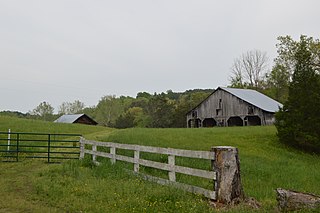
Estes Farm is a historic home and farm complex located near Dyke, Albemarle County, Virginia. It includes a c. 1840 log dwelling and a c. 1880 wood framed main house, as well as numerous supporting outbuildings including a large barn, an icehouse/well house, a tenant house, the log dwelling, a small hay/tobacco barn, a garage, and three small sheds. Also on the property is a contributing truss bridge. The house is a two-story, three-bay frame I-house building with a hipped roof. A two-story half-hipped central rear ell was added in 1976. It is representative of a transitional Greek Revival / Italianate style. It features a one-story three-bay porch fronting the central entrance, and exterior-end brick chimneys.
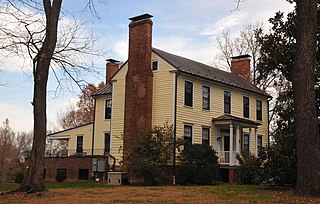
John Gunnell House, also known as the George Coleman House, is a historic home near Great Falls, Fairfax County, Virginia. It was built in 1852, and is a two-story, five bay, "T"-shaped frame dwelling in a vernacular Greek Revival style. It has an English basement, attic, and intersecting gable roofs with brick chimneys at each of the three gable ends. Also on the property is a contributing outbuilding, now used as a tool shed.
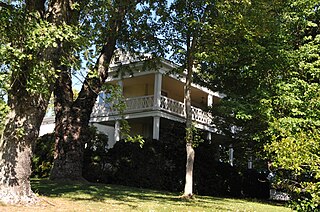
Mount Hope is a historic home located near New Baltimore, Fauquier County, Virginia. The house was built in four periods from the early-19th to early-20th centuries. The main dwelling is a 2 ½-story, three-bay, frame dwelling on a stone foundation and in the Greek Revival style. It features a double-story porch with a hipped roof and square wooden columns. Also on the property are the contributing bank barn, a machine shed, a smokehouse, and a spring house dating from the 19th century; an early-20th-century shed; a well; and the Hunton Family cemetery.

Booth–Lovelace House, also known as the Overhome Bed and Breakfast, is a historic home located near Hardy, Franklin County, Virginia. It was built in approximately 1859 and is a large, two-story, frame dwelling with weatherboard siding. It has a metal-sheathed hip roof above a bracketed Italianate cornice and three Greek Revival one-story porches. Also on the property are a contributing office / dwelling, ash house, granary, barn, and spring. The house was converted to a bed and breakfast in the 1990s.

Greer House is a historic home located at Rocky Mount, Franklin County, Virginia. It is a two-story, three bay, frame dwelling in the Greek Revival style. It has a low hipped roof and is sheathed on weatherboard. The front facade features a full width, one-story front porch topped by a balustrade. The building was started in 1861. It was originally "T"-shaped, until a series of three small building campaigns altered the form of the dwelling to resemble a square.

Bolling Island is a historic plantation house located overlooking the upper James River near Goochland, Goochland County, Virginia. The original frame section, now the east wing, was built in 1771. The principal two-story, hipped roof brick core was built between 1800 and 1810.
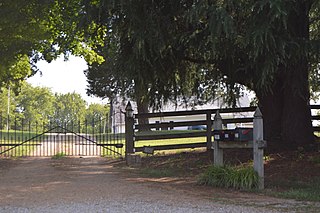
Mount Bernard Complex, also known as Lightfoot's Beaverdam Plantation and Kameschatka, is a historic plantation house and farm complex located near Maidens, Goochland County, Virginia. The main dwelling was built about 1850, and consists of a central gabled pavilion is flanked by subsidiary wings. It sits on a stone foundation dating to the 18th century. The house was altered in the 1920s in the Classical Revival style. Additions in the 1920s and 1940s to the sides and rear have subsequently turned the original "T"-shaped plan into a rectangle. Also on the property are the contributing two secondary dwellings, a slave quarters / kitchen, an ice house and cool chamber, a large barn / stable, two smaller stables, a corn crib, an equipment shelter, and a well house.

Ben Dover, also known as Ben Dover Farm, is a historic home and plantation complex, recognized as a national historic district, located near Manakin-Sabot in Goochland County, Virginia, United States. The district encompasses 13 contributing buildings, 8 contributing sites, and 10 contributing structures.

Oak Grove is a historic home located near Manakin-Sabot, Goochland County, Virginia. The central block of the main dwelling was built about 1850 in the Greek Revival style. It is two stories high and three bays wide, and features a full-width front porch with Doric order-style square columns and engaged pilasters. A semidetached one-story, two-bay wing, was built about 1820, and a two-story, two-bay rear wing was added about 1866. Also on the property are the contributing one-story heavy timber frame meat house, a one-story frame barn, a brick-and-stone-lined circular well, and the stone foundations of two historic dependencies.

Rochambeau Farm is a historic home and farm complex located near Manakin-Sabot, Goochland County, Virginia. The main dwelling was built about 1855, and is an "L"-shaped full two-story frame structure set on a common bond brick foundation in the Greek Revival style. It has a low hip roof and three single-story colonnade porches.
Howard's Neck Plantation is a historic house and plantation complex located near the unincorporated community of Pemberton, in Goochland County, Virginia. It was built about 1825, and is a two-story, three-bay brick structure in the Federal style. The house is similar in style to the works of Robert Mills. It has a shallow deck-on-hip roof and a small, one-story academically proportioned tetrastyle Roman Doric order portico.

The Dover Slave Quarter Complex is a set of five historic structures located on Brookview Farm near Manakin-Sabot, Goochland County, Virginia. They were built as one-story, two-unit, brick structures with steep gable roofs for housing African-American slaves. The houses are arranged in a wide arc, measuring 360 ft (110 m) in length. The center dwelling had a frame second-story added and its brick walls covered by siding when it was converted to an overseer's house. It has a recent rear addition.

Oakley Hill is a historic plantation house located near Mechanicsville, Hanover County, Virginia. It was built about 1839 and expanded in the 1850s. It is a two-story, frame I-house dwelling in the Greek Revival style. On the rear of the house is a 1910 one-story ell. The house sits on a brick foundation, has a standing seam metal low gable roof, and interior end chimneys. The front facade features a one-story front porch with four Tuscan order columns and a Tuscan entablature. Also on the property are a contributing smokehouse and servants' house.
Strickler–Louderback House is a historic home located near Shenandoah, Page County, Virginia. It was built in 1852, and is a two-story, five bay, brick dwelling with a two-story rear ell. It has a metal-sheathed gable roof, gable-end chimneys, and a one-story Greek Revival style front porch. The interior features Federal and Greek Revival style decorative detailing. It was renovated in 1989–1993. Also on the property are the contributing "L"-shaped outbuilding, grape arbor, chicken house, and family cemetery.

Longwood House is a historic home located at Farmville, Prince Edward County, Virginia, and functions as the home of the president of Longwood University. It is a 2+1⁄2-story, three bay, frame dwelling with a gable roof. It features Greek Revival style woodwork and Doric order porch. Longwood House has a central passage, double-pile plan. It has a two-story wing added about 1839, and a second wing added in the 1920s, when the property was purchased by Longwood University. The house is located next to the university golf course, and since 2006, athletic fields used by the Longwood Lancers.
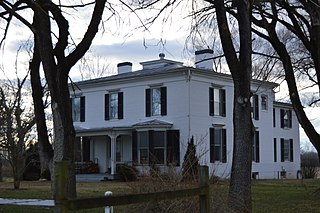
Bon Air, also known as the Adam and Susan Bear House and Bear Lithia, is a historic home located near Elkton, Rockingham County, Virginia. It was built about 1870, and is a two-story, central-passage plan brick dwelling with Italianate and Greek Revival style decorative details. It has a metal-sheathed, hip-and-deck roof, a rear two story ell, front and back porches, and two one-story bay windows on the front facade. Also on the property is a contributing two-level meat house/storage building. The house stands next to Bear Lithia Springs, a boldly flowing water source acquired by the Bear family during the colonial period and commercially exploited in the late-19th and early-20th centuries.
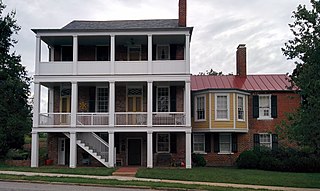
The Rowe House is a historic home located at Fredericksburg, Virginia. It was built in 1828, and is a two-story, four-bay, double-pile, side-passage-plan Federal style brick dwelling. It has an English basement, molded brick cornice, deep gable roof, and two-story front porch. Attached to the house is a one-story, brick, two-room addition, also with a raised basement, and a one-story, late 19th century frame wing. The interior features Greek Revival-style pattern mouldings. Also on the property is a garden storage building built in about 1950, that was designed to resemble a 19th-century smokehouse.






















